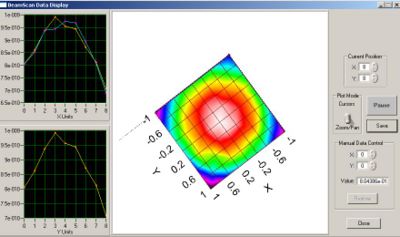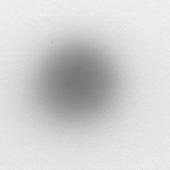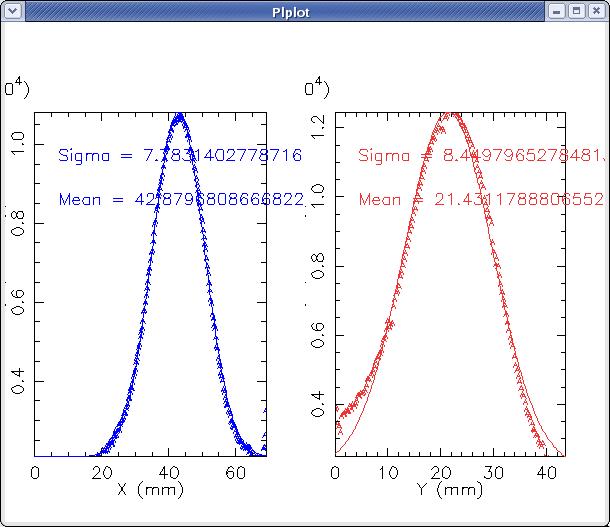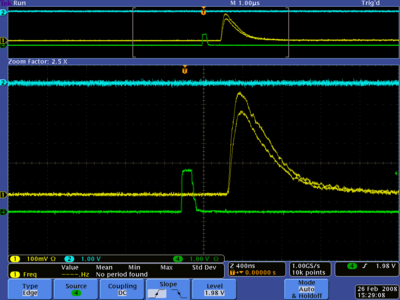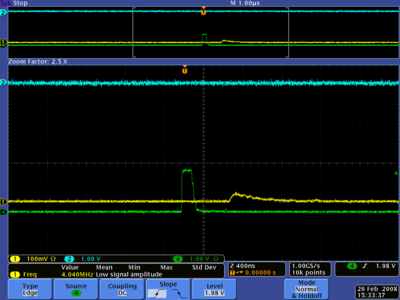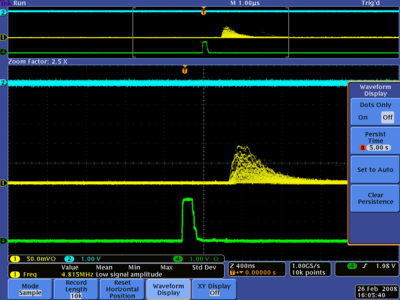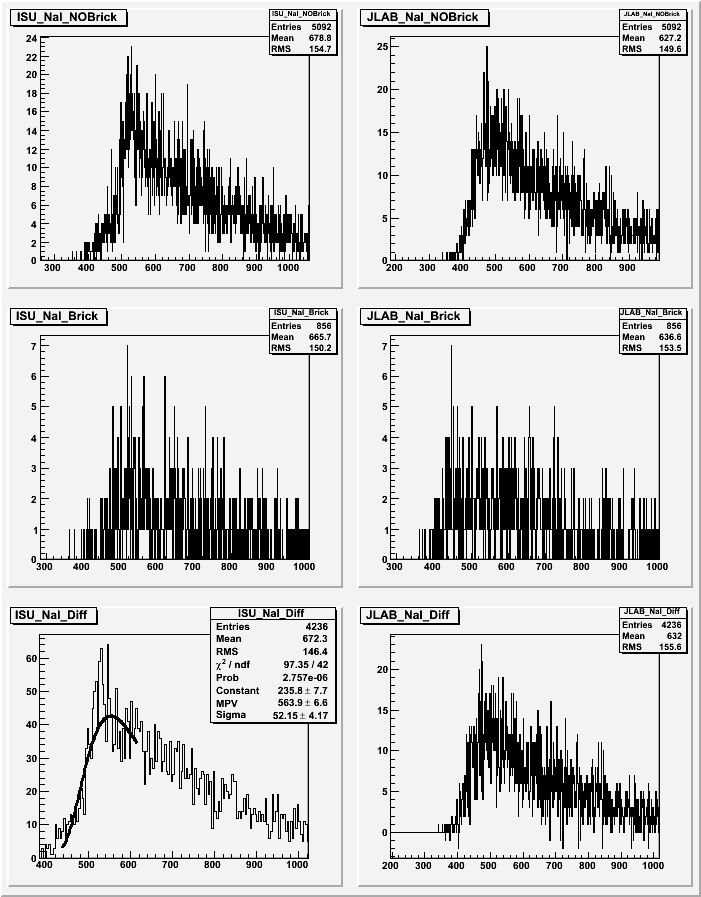Difference between revisions of "CHIPS Run Feb-2008"
| (4 intermediate revisions by the same user not shown) | |||
| Line 38: | Line 38: | ||
---- | ---- | ||
Analysis of exposed glass plate. Glass plate exposed to 4mA of beam current, positioned at exit of straight ahead section on D2. | Analysis of exposed glass plate. Glass plate exposed to 4mA of beam current, positioned at exit of straight ahead section on D2. | ||
| + | No quad scanning were made due to the lack of diagnostics. | ||
| + | Another dignostics over the beam current made with the Faraday cup and toroid. It turns out that, IAC can deliver 4mA as the lowest electron beam current. | ||
Raw Image: | Raw Image: | ||
| Line 189: | Line 191: | ||
Relative intensity (Beam photons above 1 MeV)/(Beam Positrons) = (5058/ (50% relative detection probability) ) / 22090 | Relative intensity (Beam photons above 1 MeV)/(Beam Positrons) = (5058/ (50% relative detection probability) ) / 22090 | ||
Relative intensity = 0.5 | Relative intensity = 0.5 | ||
| + | |||
| + | Need to refine this gamma calculation by estimating probality for 2 (1 MeV) gammas in beam to each Compton scatter by 90 deg | ||
| + | and land in coincidence in the two NaI detectors. Note that total probality of Compton scattering of 1 MeV gamma in | ||
| + | 10cm Al is approx 100% Cross section is highly non-isotropic, but geometrical acceptance is 1% of 4pi. | ||
| + | |||
| + | |||
Of the 22090 coincidence events roughly 17000 were positrons in beam | Of the 22090 coincidence events roughly 17000 were positrons in beam | ||
| Line 199: | Line 207: | ||
From the 0.5 relative gamma/positron intensity, we | From the 0.5 relative gamma/positron intensity, we | ||
extrapolate a photon intensity above 1 MeV = 12 gamma/burst | extrapolate a photon intensity above 1 MeV = 12 gamma/burst | ||
| + | |||
| + | For photons 1 to 10 MeV, dominant absorbtion in Al is Compton effect. | ||
| + | Probability of detecting scattered compton photon in NaI is less than geometrical acceptance of 1%. | ||
| + | Probability of random coincidence of the two Compton gammas if there are N_gamma 1MeV photons per burst is | ||
| + | (N_gamma * sigma_Compton-into-NaI*acceptance)^2 < (N_gamma*0.01)^2. | ||
| + | Estimated number of gamma coincidences detected is 0.15 / burst | ||
| + | Therefore estimate is N_gamma > 40 /burst | ||
| + | (this is larger than the 12/burst estimated assuming all gammas detected via positron production+annihilation). | ||
511 gamma peak in ADC at around channel 500 | 511 gamma peak in ADC at around channel 500 | ||
| Line 209: | Line 225: | ||
ADC11 saturated/overflow from channel 3800 (4 MeV). | ADC11 saturated/overflow from channel 3800 (4 MeV). | ||
Need to remove amplifier gain of 50 to reduce 87 MeV signal to channel 1700 | Need to remove amplifier gain of 50 to reduce 87 MeV signal to channel 1700 | ||
| + | |||
| + | 4 mA beam at 60 Hz = 4mC/(60 burst) = (4.e-3 C) / (60 burst * 1.6e-19 C/e-) = 4.e14 e-/burst | ||
| + | |||
| + | (25 positrons)/(4e14 electrons) = 6.e-13 positrons/electrons. | ||
| + | This yield is so low that it could all be secondary positrons from gammas hitting the beam pipe. | ||
| + | |||
| + | |||
| + | |||
| + | [http://www.iac.isu.edu/mediawiki/index.php/Positrons Go back] | ||
Latest revision as of 20:29, 5 April 2008
2-25-08
Configure 25 Mev Beam line
NaI Detector
PMT HV 1500 Co-60 1microCi source: 1MeV band at about 55mV
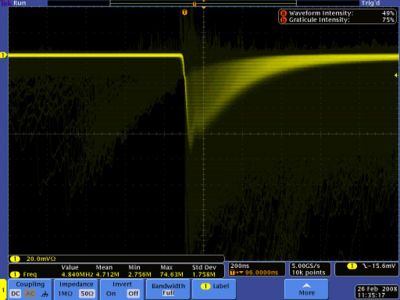
PMT HV 1500 no source, noisey tube
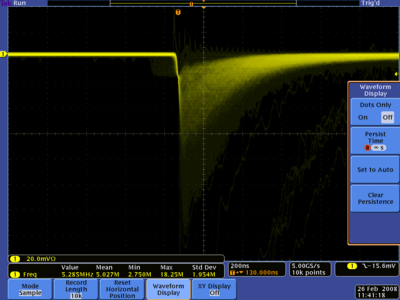
IAC NaI Detector Calibrated with 10 Ci Co60 source with high voltage power supply at 1300 Volt. 1 MeV apprx. equal to 60 mV on the scope
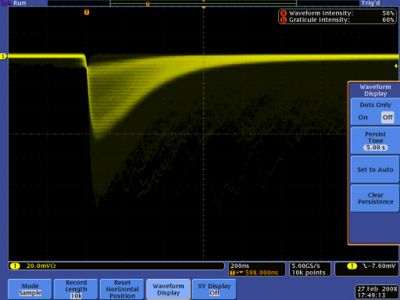
JLAB NaI Detector Calibrated with 10 Ci Co60 source with high voltage power supply at 1500 Volt. 1 MeV apprx. equal to 70 mV on the scope
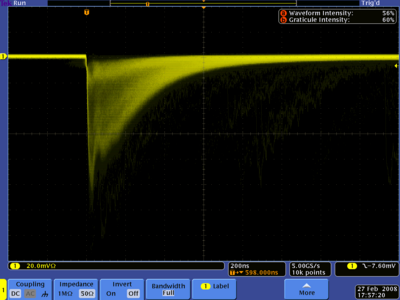
Beam Profile
1.5 inch FWHM beam profile measured at 8 mA peak current. The units on the beam scan is in inches. so the grid is 2inch by 2 inch (5cm by 5cm). Frequency is 60 Hz.
_________________________________ 4 mA peak current
_______________________________________________
Analysis of exposed glass plate. Glass plate exposed to 4mA of beam current, positioned at exit of straight ahead section on D2. No quad scanning were made due to the lack of diagnostics.
Another dignostics over the beam current made with the Faraday cup and toroid. It turns out that, IAC can deliver 4mA as the lowest electron beam current. Raw Image:
Projections and fits:
Beam on
15:20:
Turned beam on zero degree port and NaI lights up whan positioned just after the beam pipe window.
Must be gammas Rate = 10 count/sec. Anode amplified (x64) then discriminated and put into a scaler. Threshold on discriminator is 2 Volts and results in zero counts when beam off. NaI PMT at 1500 volts.
15:30:
Now move NaI detector so it is near experimental Cell wall. Just inside the wall
Gamma rate goes to zero!
Now change scope to 5 sec accumulation. 1 Mev electron should give 55 mV pulse on scope.
16:00:
Now try to put electrons into Experimental cell.
We turned on the first dipole to deflect 10 MeV electrons onto the Tungsten target. The quads between the two dipoles were used to minimize the rates on the NaI. Then we turned on the last dipole to deflect 3 MeV electrons into the Experimental cell. And measured the following rates
811 counts /15 sec threshold at a minimim
Now insert 1.2 cm thick Aluminum plate in front of the NaI in order to capture all the electrons and measure the gamma rate.
776 counts /15 sec threshold at a minimim
2-27-08
Channel 6 : IAC NaI : Co-60 source gave 20 mV pulses on scope when PMT at 1200 Volts
Channel 10: JLab NaI : Co-60 source gave ~40 mV pulses on scope when PMT at 1400 Volts
Positron Runs with DAQ
Run 393: 1400 V JLAB NaI, 1209 Volts on ISU NaI, Trigger: (Gun AND NaI 1 ) OR (Gun AND NaI2), 50 mV Discriminator Threshold
Run 394: 1400 V JLAB NaI, 1209 Volts on ISU NaI, Trigger: (Gun AND NaI 1 ) AND (Gun AND NaI2), 50 mV Discriminator Threshold
Run 395: 1400 V JLAB NaI, 1209 Volts on ISU NaI, Trigger: (Gun AND NaI 1 ) AND (Gun AND NaI2), 30 mV Discriminator Threshold
Run 396: 1400 V JLAB NaI, 1209 Volts on ISU NaI, Trigger: (Gun AND NaI 1 ) AND (Gun AND NaI2), 30 mV Discriminator Threshold, Increase dynode amplier from x20 to x50 to raise trigger threshold.
Run 397: 1500 V JLAB NaI, 1300 Volts on ISU NaI, Trigger: (Gun AND NaI 1 ) AND (Gun AND NaI2), 30 mV Discriminator Threshold, Increase dynode amplier at x50 to raise trigger threshold.
Run 398: 1500 V JLAB NaI, 1300 Volts on ISU NaI, Trigger: (Gun AND NaI 1 ) AND (Gun AND NaI2), 30 mV Discriminator Threshold, Increase dynode amplier from at x50 to raise trigger threshold. Insert 4" thick Aluminum in front of positron stop. SHould see rate die if we have positrons but gammas will come through.
Start time:16:03:25 Stop Time: 16:23:57
47 Count/60 seconds
Run 399: 1500 V JLAB NaI, 1300 Volts on ISU NaI, Trigger: (Gun AND NaI 1 ) AND (Gun AND NaI2), 30 mV Discriminator Threshold, Increase dynode amplier from at x50 to raise trigger threshold. Removed 4" thick Aluminum in front of positron stop.
252 counts/ 60 seconds
Changed first dipole and measured 10 mA beam current after zero degree port
Run 400: 1500 V JLAB NaI, 1300 Volts on ISU NaI, Trigger: (Gun AND NaI 1 ) AND (Gun AND NaI2), 30 mV Discriminator Threshold, Increase dynode amplier from at x50 to raise trigger threshold. Change last dipole polarity. Check electron rate .
172 counts/min
Run 401: 1500 V JLAB NaI, 1300 Volts on ISU NaI, Trigger: (Gun AND NaI 1 ) AND (Gun AND NaI2), 30 mV Discriminator Threshold, Increase dynode amplier from at x50 to raise trigger threshold. Change back to Positron polarity. Check electron rate
.
242 counts/min
Histograms
The histograms below are the results of previous runs. Brick means, all the positrons were stopped at the brick and coincidence measruement was made to detect secondaries, background and noise. NOBrick means, the Al brick was removed and only 2"X2" Al absorber exist. The bottom histograms are the subtractions of brick and NOBrick histos for each NaI.
Channel 10: ISU NaI : Co-60 source gave 60 mV pulses on scope when PMT at 1400 Volts
02-29-08
He tube insterted between exit window and experimental cell. Some ISU/JLAB detector work overnight. Re-established HV and signal connections.
Run 403, 404 and 405 are no good. The ADC gate had shifted relative to the signal and needed to be re-adjusted. Gate width increased to 2seconds to capture complete NaI signal.
ADC plots now look similar to yesterdays.
Coincidence rate today is about 718 cnts/60secs, factor of three more than yesterday....????....
Run 406:
Trigger: And
Threshold: 30mV/30mV (IAC/JLAB NaI)
Gain in trigger: 50/50
HV: 1300/1500
Run 407: Installed permanant magnet after last quadrupole doublet (0.7kGauss field, about 6inches long) to sweep away charged particles (electrons, positrons and pentaquarks) for background studies.
Trigger: And
Threshold: 30mV/30mV
Gain: 50/50
HV: 1300/1500
Coincidence Rate: 360 cnts/60secs
Run 408 : Skipped due to overflow
Run 409 : Changed the setting from coincidence to straight ahead measurement. Jlab NaI was put on the beamline.
Analysis
CEH & SG Run 407. 100% of charged particles less than 10MeV/c should be deflected by magnet into wall before target/detector in experimental cell. Target in Exp cell = 4 in Al = approx 1 Radiation length Probability of conversion of photon above 1 MeV to e+e- pair = 1-exp(X/X0) approx 60% dEdX in Al = 1.6 MeV/cm. All positrons produced in first 8cm of Al will stop in Al == 80% positron annihilation probability. Target X coinc NaI configuration, run 406 & 407 Ratio (Detection efficiency for beam photons of energy > 1.0 MeV)/(Beam positron detection efficiency) = (0.6)*(0.8) = 50% Run 406 number of positron annihilation candidates (ADC7 X ADC11) = 22090 Run 407 number of positron annihilation candidates = 5058 Relative intensity (Beam photons above 1 MeV)/(Beam Positrons) = (5058/ (50% relative detection probability) ) / 22090 Relative intensity = 0.5
Need to refine this gamma calculation by estimating probality for 2 (1 MeV) gammas in beam to each Compton scatter by 90 deg and land in coincidence in the two NaI detectors. Note that total probality of Compton scattering of 1 MeV gamma in 10cm Al is approx 100% Cross section is highly non-isotropic, but geometrical acceptance is 1% of 4pi.
Of the 22090 coincidence events roughly 17000 were positrons in beam
If run was 10 min at 60 Hz = 36000 beam bursts. 17000 positrons/36000 burst = 0.5 positron coicidences per beam burst
2" NaI 6" from Al beam stop. Solid angle = (2/6)^2 = 1/9 sr. Fraction of 4pi = 1/100. Coincidence probability for back to back events = 2% Therefore beam flux was (0.5 coincidences/burst) / (2% efficiency) = 25 e+/burst From the 0.5 relative gamma/positron intensity, we extrapolate a photon intensity above 1 MeV = 12 gamma/burst
For photons 1 to 10 MeV, dominant absorbtion in Al is Compton effect. Probability of detecting scattered compton photon in NaI is less than geometrical acceptance of 1%. Probability of random coincidence of the two Compton gammas if there are N_gamma 1MeV photons per burst is (N_gamma * sigma_Compton-into-NaI*acceptance)^2 < (N_gamma*0.01)^2. Estimated number of gamma coincidences detected is 0.15 / burst Therefore estimate is N_gamma > 40 /burst (this is larger than the 12/burst estimated assuming all gammas detected via positron production+annihilation).
511 gamma peak in ADC at around channel 500
Run 409 NaI in beam in Exp cell Expect 3MeV signal in channel 3000 average signal expected from run 406/407 = (25 e+)(3MeV/e+) + (12 gamma)(1MeV/gamma) = Pileup per burst = 87 MeV ADC11 saturated/overflow from channel 3800 (4 MeV). Need to remove amplifier gain of 50 to reduce 87 MeV signal to channel 1700
4 mA beam at 60 Hz = 4mC/(60 burst) = (4.e-3 C) / (60 burst * 1.6e-19 C/e-) = 4.e14 e-/burst
(25 positrons)/(4e14 electrons) = 6.e-13 positrons/electrons. This yield is so low that it could all be secondary positrons from gammas hitting the beam pipe.
